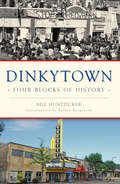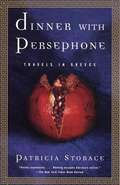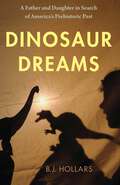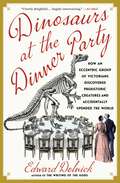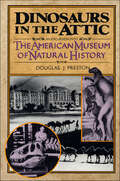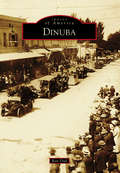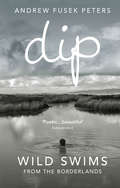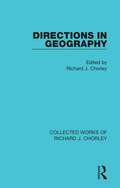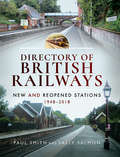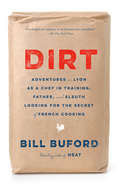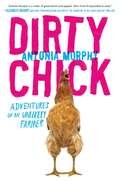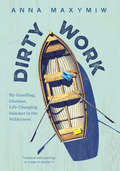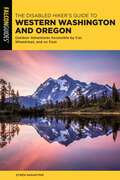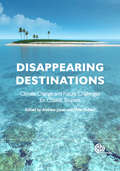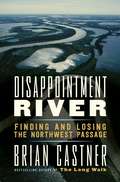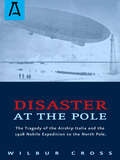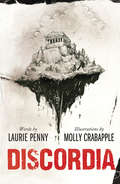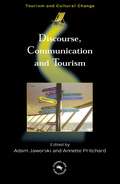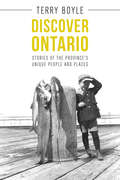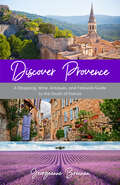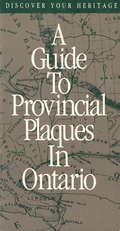- Table View
- List View
Dinkytown: Four Blocks of History (Brief History)
by Bill Huntzicker Steven BergersonDinkytown belies its name with a big history and outsized influence on the culture of Minneapolis. It began as a business district serving the University of Minnesota and became a creative center between the flour milling district and a massive railroad yard. By 1875, Dinkytown was a terminus on the horse-drawn streetcar system. The area transformed into a nexus of culture and counterculture with the growth and expansion of the university. Its burgeoning arts scene launched Bob Dylan and The Fiddler on the Roof, and its student activism spawned the Red Barn protests of 1970. Dr. Bill Huntzicker narrates the enthralling history of one of Minneapolis's most influential neighborhoods.
Dinner with Persephone: Travels in Greece
by Patricia StoraceA New York Times Notable Book of the Year "Full of insights, marvelously entertaining . . . haunting and beautifully written. " --The New York Review of Books "I lived in Athens, at the intersection of a prostitute and a saint. " So begins Patricia Storace's astonishing memoir of her year in Greece. Mixing affection with detachment, rapture with clarity, this American poet perfectly evokes a country delicately balanced between East and West. Whether she is interpreting Hellenic dream books, pop songs, and soap operas, describing breathtakingly beautiful beaches and archaic villages, or braving the crush at a saint's tomb, Storace, winner of the Whiting Award, rewards the reader with informed and sensual insights into Greece's soul. She sees how the country's pride in its past coexists with profound doubts about its place in the modern world. She discovers a world in which past and present engage in a passionate dialogue. Stylish, funny, and erudite, Dinner with Persephone is travel writing elevated to a fine art--and the best book of its kind since Henry Miller's The Colossus of Maroussi."Splendid. Storace's account of a year in Greece combines past and present, legend and fact, in an unusual and delightful whole. " --Atlantic Monthly
Dinosaur Dreams: A Father and Daughter in Search of America's Prehistoric Past
by B.J. HollarsIn the summer of 2023, one of the hottest on record, B.J. Hollars and his nine-year-old daughter Ellie embarked on a two-thousand-mile road trip to complete the Montana Dinosaur Trail, a fourteen-stop trail consisting of museums, state parks, and dinosaur dig sites throughout a state known for its Mesozoic-era fossil record. Throughout their two-week journey, they dig fossils, learn from amateur and professional paleontologists, and forge a bond even stronger than the dinosaurs they love. Join B.J. and Ellie on a road trip that spans not just miles but millennia. With every stop, they deepen their understanding of dinosaurs, extinction, and what the fossil record might teach us about how best to preserve our planetary home. Together, father and daughter strive to answer the vital question of our age: Can we humans evolve fast enough to ensure our own survival? Charming, thought-provoking, and full of discovery, Dinosaur Dreams is a time-traveling adventure that reminds us of what truly matters: the bonds we forge, the world we inherit, and the future we fight to protect.
Dinosaur Tracks from Brazil: A Lost World of Gondwana (Life of the Past)
by Giuseppe Leonardi Ismar de CarvalhoDinosaur Tracks from Brazil is the first full-length study of dinosaurs in Brazil. Some 500 dinosaur trackways from the Cretaceous period still remain in the Rio do Peixe basins of Brazil, making it one of the largest trackways in the world. Veteran paleontologists Giuseppe Leonardi and Ismar de Souza Carvalho painstakingly document and analyze each track found at 37 individual sites and at approximately 96 stratigraphic levels. Richly illustrated and containing a wealth of data, Leonardi and de Souza Carvalho brilliantly reconstruct the taxonomic groups of the dinosaurs from the area and show how they moved across the alluvial fans, meandering rivers, and shallow lakes of ancient Gondwana. Dinosaur Tracks from Brazil is essential reading for paleontologists.
Dinosaurs at the Dinner Party: How an Eccentric Group of Victorians Discovered Prehistoric Creatures and Accidentally Upended the World
by Edward DolnickFrom the bestselling author of The Clockwork Universe and The Writing of the Gods, a historical adventure story about the eccentric Victorians who discovered dinosaur bones, leading to a whole new understanding of human history.In the early 1800s the world was a safe and cozy place. But then a twelve-year-old farm boy in Massachusetts stumbled on a row of fossilized three-toed footprints the size of dinner plates—the first dinosaur tracks ever found. Soon, in England, Victorians unearthed enormous bones—bones that reached as high as a man&’s head. No one had ever seen such things. Outside of myths and fairy tales, no one had even imagined that creatures like three-toed giants had once lumbered across the land. And if anyone had somehow conjured up such a scene, they would never have imagined that all those animals could have vanished, hundreds of millions years ago. The thought of sudden, arbitrary disappearance from life was unnerving and forced the Victorians to rethink everything they knew about the world. Now, in Dinosaurs at the Dinner Party, celebrated storyteller and historian Edward Dolnick leads us through a compelling true adventure as the paleontologists of the first half of the 19th century puzzled their way through the fossil record to create the story of dinosaurs we know today. The tale begins with Mary Anning, a poor, uneducated woman who had a sixth sense for finding fossils buried deep inside cliffs; and moves to a brilliant, eccentric geologist named William Buckland, a kind of Doctor Doolittle on a mission to eat his way through the entire animal kingdom; and then on to Richard Owen, the most respected and the most despised scientist of his generation. Entertaining, erudite, and featuring an unconventional cast of characters, Dinosaurs at the Dinner Party tells the story of how the accidental discovery of prehistoric creatures upended humanity&’s understanding of the world and their place in it, and how a group of paleontologists worked to bring it back into focus again.
Dinosaurs in the Attic: An Excursion into the American Museum of Natural History
by Douglas J. PrestonDinosaurs in the Attic is a chronicle of the expeditions, discoveries, and scientists behind the greatest natural history collection ever assembled. Written by former Natural History columnist Douglas J. Preston, who worked at the American Museum of Natural History for seven years, this is a celebration of the best-known and best-loved museum in the United States.
Dinuba: A Place Of New Beginnings (Images of America)
by Ron DialOn May 11, 1880, tensions between central California settlers and the Southern Pacific Railroad culminated in a violent shoot-out that left seven people dead. This event, known as the Mussel Slough Tragedy, was a result of the attempted evictions of settlers from land they had already purchased and the high land prices imposed by the expanding railroad. Founded in 1890 by James Patterson and James Sibley, Dinuba was an effort for Mussel Slough farmers to peacefully resettle in the San Joaquin Valley and pursue their agricultural interests. The region's fertile soils and warm climate made the land ideal for farming and economic growth. With the development of a reliable water source and the importation of Thompson's Seedless grapes, raisins quickly became the cash crop, and Dinuba, nicknamed "The Raisin City," entered the 20th century as an established and rapidly growing community. Today, the city's unique history is preserved through the Depot Museum, maintained and operated by the Alta District Historical Society.
Dip: Wild Swims from the Borderlands
by Andrew Fusek PetersIn Dip, Andrew Fusek Peters describes an extraordinary year of wild swimming. He leads us to rivers, lakes, waterfalls and hidden pools, into untamed landscapes that have the potential to surprise and move us in unexpected ways. Following in the wake of great writers such as Richard Jefferies and Edward Thomas, Dip combines meditations on place, history and myth with sharp observation and a poet's eye. As he takes the plunge and immerses himself in the elements, Andrew also begins to surface from a deep depression, making Dip at once a personal journey and about the many ways in which wild water and nature can restore us to ourselves.
Directions in Geography (Collected Works of Richard J. Chorley)
by Richard J. ChorleyOriginally published in 1973. This collection of essays looks at the ‘quantitative revolution’ and the ‘new geography’ by some of the geographers who had a significant part in those innovations and looks ahead to further developments. The views in the chapters are diverse and offer a fascinating glimpse of the discipline of geography as the subject was undergoing such change and becoming more socially committed. They cover theory, spatial-systems theory, forecasting, human ecology and climatology alongside the teaching of the subject. The concerns of the contemporary geographer come across and are of interest today as these areas have developed still more.
Directory of British Railways: New and Reopened Stations 1948–2018
by Paul Smith Sally SalmonYour comprehensive and indispensable guide to operational British Railway stations—including facilities available—from A to Z. Following nationalization in 1948, British Railways closed many branch lines and reduced the number of stations on the network. In January 1978, there were 2,358 and by January 2018 there were 2,560 stations on the network. The object of this book is to record those stations that are re-opened or are new stations to the system. The book gives: locations, facilities, chronology, statistics and passenger usage. &“This useful reference work describes all the 200 or so stations opened or re-opened over the last 70 years, with a recent photograph of each and listed alphabetically. Print quality is excellent.&” —West Somerset Railway Association &“Authors Paul Smith and his stepdaughter Sally Salmon . . . have travelled widely to compile their Directory of British Railways and hunt down reopened stations, brand new stations, old stations which have been revived or reopened on adjacent sites, replacements, and private or non-timetabled stations which have become public stations.&” —Express & Star
Dirt: Adventures in Lyon as a Chef in Training, Father, and Sleuth Looking for the Secret of French Cooking
by Bill BufordThe hugely anticipated follow up to Heat--Bill Buford's hilariously self-deprecating, highly obsessive adventures in the world of French haute cuisine. <P><P>In Dirt, Bill Buford--author of the best-selling, now-classic, Heat--moves his attention from Italian cuisine to the food of France. Baffled by the language, determined that he can master the art of French cooking--or at least get to the bottom of why it is so revered--Buford begins what will become a five-year odyssey by shadowing the revered French chef Michel Richard in Washington, D.C. <P><P>He soon realizes, however, that a stage in France is necessary, and so he goes--this time with his wife and three-year-old twin sons in tow--to Lyon, the gastronomic capital of France. Studying at l'Institut Bocuse, cooking at the storied, Michelin-starred Mère Brazier, Buford becomes a man obsessed--to prove that French cooking actually derives from the Italian, to prove himself on the line, to prove that he is worthy of these gastronomic secrets. <P><P>With his signature humor, sense of adventure, and masterful ability to immerse himself in his surroundings, Bill Buford has written what is sure to be the food-lover's book of the year.
Dirt: Adventures in Lyon as a Chef in Training, Father, and Sleuth Looking for the Secret of French Cooking (Granta Ser.)
by Bill Buford&“You can almost taste the food in Bill Buford&’s Dirt, an engrossing, beautifully written memoir about his life as a cook in France.&” —The Wall Street JournalWhat does it take to master French cooking? This is the question that drives Bill Buford to abandon his perfectly happy life in New York City and pack up and (with a wife and three-year-old twin sons in tow) move to Lyon, the so-called gastronomic capital of France. But what was meant to be six months in a new and very foreign city turns into a wild five-year digression from normal life, as Buford apprentices at Lyon&’s best boulangerie, studies at a legendary culinary school, and cooks at a storied Michelin-starred restaurant, where he discovers the exacting (and incomprehensibly punishing) rigueur of the professional kitchen. With his signature humor, sense of adventure, and masterful ability to bring an exotic and unknown world to life, Buford has written the definitive insider story of a city and its great culinary culture.
Dirty Chick
by Antonia Murphy"One month into our stay, we'd managed to dispatch most of our charges. We executed the chickens. One of the cats disappeared, clearly disgusted with our urban ways. And Lucky [the cow] was escaping almost daily. It seemed we didn't have much of a talent for farming. And we still had eleven months to go."Antonia Murphy, you might say, is an unlikely farmer. Born and bred in San Francisco, she spent much of her life as a liberal urban cliché, and her interactions with the animal kingdom rarely extended past dinner.But then she became a mother. And when her eldest son was born with a rare, mysterious genetic condition, she and her husband, Peter, decided it was time to slow down and find a supportive community. So the Murphys moved to Purua, New Zealand--a rural area where most residents maintained private farms, complete with chickens, goats, and (this being New Zealand) sheep. The result was a comic disaster, and when one day their son had a medical crisis, it was also a little bit terrifying.Dirty Chick chronicles Antonia's first year of life as an artisan farmer. Having bought into the myth that farming is a peaceful, fulfilling endeavor that allows one to commune with nature and live the way humans were meant to live, Antonia soon realized that the reality is far dirtier and way more disgusting than she ever imagined. Among the things she learned the hard way: Cows are prone to a number of serious bowel ailments, goat mating involves an astounding amount of urine, and roosters are complete and unredeemable assholes.But for all its traumas, Antonia quickly embraced farm life, getting drunk on homemade wine (it doesn't cause hangovers!), making cheese (except for the cat hair, it's a tremendously satisfying hobby), and raising a baby lamb (which was addictively cute until it grew into a sheep). Along the way, she met locals as colorful as the New Zealand countryside, including a seasoned farmer who took a dim view of Antonia's novice attempts, a Maori man so handy he could survive a zombie apocalypse, and a woman proficient in sculpting alpaca heads made from their own wool.'Part family drama, part cultural study, and part cautionary tale, Dirty Chick will leave you laughing, cringing, and rooting for an unconventional heroine.
Dirty Work: My Gruelling, Glorious, Life-changing Summer In the Wilderness
by Anna MaxymiwLands of Lost Borders meets The Electric Woman in this vibrant coming-of-age memoir about a young woman's fierce, filthy, exhausting, and joyous experience working at a wilderness lodge.When Anna Maxymiw accepts a summer job as a housekeeper at a fishing lodge in Northern Ontario, she has little idea what to expect. At twenty-three, she has decided to step away from her master's degree and city life to board a floatplane bound for the remote boreal forest. For sixty-seven days, Anna will be working and living alongside twelve strangers. Together this group of young men and women will keep the lodge running. While the fishing guides head out on the water with the fishermen who are the lodge's guests, the women stay on land to clean and serve. Against the backdrop of a vast lake, wild storms, and hot days and eerily still nights, Anna encounters bears, bugs, and the lore surrounding the lake's legendary pike. As the summer progresses, complex (and sometimes fraught) bonds form between the men and women who work at the lodge, the ownership of the lodge changes hands, and tensions build. And Anna notices a shift in her outlook, too: she finds herself letting go of fears and insecurities and welcoming surprises and possibilities, both good and bad, with a willingness to be changed by them.Warm, funny, vulnerable, and wise, Dirty Work offers a singular perspective on the age-old impulse to leave familiar surroundings behind. This memoir is for anyone who has ever felt the urge to test themselves and wondered how they'd fare and who they'd be when they come out on the other side.
Disabled Hiker's Guide to Western Washington and Oregon: Outdoor Adventures Accessible by Car, Wheelchair, and on Foot
by Syren NagakyrieThe Disabled Hiker&’s Guide to Western Washington and Oregon is the first book of its kind to consider the diverse needs of disabled people in the outdoors. This groundbreaking guidebook includes 60 outdoor adventures, including drive-up experiences, verified wheelchair accessible trails, and foot trails suitable for disabled hikers. This guide removes one of the barriers to access - a lack of information - by utilizing a rating system and detailed trail information designed for the disability community. Each trail is personally assessed according to Syren&’s skilled and detailed review and established accessibility guidelines.
Disappearing Destinations:
by Dr Bas Amelung Dr Giorgio Anfuso Dr Andrew L Jones Dr Michael PhillipsProviding a thorough examination of the threats posed to destinations by tourism, this comprehensive text discusses how popular and fragile destinations such as the Great Barrier Reef could become severely damaged and forced to close to tourists if current tourism trends continue. The consequences of tourism growth, predicted changes, and management and policy responses are reviewed. The book will explore tourism in the context of climate change and vulnerable environments, exploring the situation at local level and in a wider perspective using international case studies throughout and providing future recommendations. It will be an essential text for researchers, policymakers and students in tourism, ecotourism, environmental conservation, planning, coastal management and engineering, climate change and marine conservation.
Disappointment River: Finding and Losing the Northwest Passage
by Brian CastnerIn 1789, Alexander Mackenzie travelled the 1,125 miles of the immense river in Canada that now bears his name, in search of the fabled Northwest Passage. In 2016, the acclaimed memoirist Brian Castner retraced Mackenzie's route by canoe in a grueling journey—in search of Mackenzie's Passage 200 years later.Disappointment River is a dual historical narrative and travel memoir that at once transports readers back to the heroic age of North American exploration and places them in a still rugged but increasingly fragile Arctic wilderness in the process of profound alteration by the dual forces of energy extraction and climate change. Fourteen years before Lewis and Clark, Mackenzie set off to cross the continent of North America with a team of voyageurs and Chipewyan guides. In this book, Brian Castner not only retells the story of Mackenzie's epic voyages in vivid prose, he personally retraces his travels in an 1,125-mile canoe voyage down the river that bears his name, battling exhaustion, exposure, mosquitoes, white water rapids and the threat of bears. He transports readers to a world rarely glimpsed in the media, of tar sands, thawing permafrost, remote indigenous villages and, at the end, a wide open Arctic Ocean that has the potential of becoming a far-northern Mississippi of barges and pipelines and oil money.
Disappointment River: Finding and Losing the Northwest Passage
by Brian CastnerIn 1789, Alexander Mackenzie traveled 1200 miles on the immense river in Canada that now bears his name, in search of the fabled Northwest Passage that had eluded mariners for hundreds of years. In 2016, the acclaimed memoirist Brian Castner retraced Mackenzie's route by canoe in a grueling journey -- and discovered the Passage he could not find. Disappointment River is a dual historical narrative and travel memoir that at once transports readers back to the heroic age of North American exploration and places them in a still rugged but increasingly fragile Arctic wilderness in the process of profound alteration by the dual forces of globalization and climate change. Fourteen years before Lewis and Clark, Mackenzie set off to cross the continent of North America with a team of voyageurs and Chipewyan guides, to find a trade route to the riches of the East. What he found was a river that he named "Disappointment." Mackenzie died thinking he had failed. He was wrong. In this book, Brian Castner not only retells the story of Mackenzie's epic voyages in vivid prose, he personally retraces his travels, battling exhaustion, exposure, mosquitoes, white water rapids and the threat of bears. He transports readers to a world rarely glimpsed in the media, of tar sands, thawing permafrost, remote indigenous villages and, at the end, a wide open Arctic Ocean that could become a far-northern Mississippi of barges and pipelines and oil money.
Disaster at the Pole: The Tragedy of the Airship Italia and the 1928 Nobile Expedition to the North Pole
by Wilbur CrossThe true story of the harrowing wreck of the airship Italia during a polar expedition and the heroic rescue attempts to save her and her crew. This is an intriguing and heart-stopping account of the tragic aviation disaster of Commander Umberto Nobile, an Italian aeronautic engineer and airship designer, as he led an expedition to cross the North Pole in the dirigible airship, Italia. Nobile and Norwegian explorer Roald Amundsen had previously led the first successful trip across the North Pole from Europe to America in the airship Norge, beating the attempts by American explorer Admiral Richard Byrd, during history's exciting period known as the Golden Age of Aviation. During an artic storm, the Italia suddenly crashed on an ice pack and the crew was stranded, leading to one of the world's greatest international search and rescue efforts, involving countries such as Russia, Norway, Italy, France and Great Britain.The story is both of the tremendous efforts and heroism of the many search and rescue expeditions, including internationally famous artic explorer Roald Amundsen, who was never seen again, as well as the courage and determination of Nobile and the Italia crew as they battled the elements of the polar ice fields for survival. The event also stirred international politics as Nobile was a well-known opponent to Mussolini's fascist regime and Mussolini is said to have thwarted the successful rescue of Nobile and his crew.In researching this book, author Cross personally went to Italy and interviewed Umberto Nobile as well as nine other survivors from the crash. He also worked with and interviewed the officers at the Norwegian airbase from which the Italia flew on its fatal flight. Additional information came from the Dartmouth University Institute of Artic Studies, including interviews with renowned artic explorer Vilhjalmur Stefansseon, who personally knew General Nobile.
Disasters by the Numbers: A Book of Infographics
by Steve JenkinsAn amazing look at Earth&’s natural disasters as seen through numbers, facts, and stunning infographics from Caldecott Honor–winning author-illustrator Steve Jenkins! From Caldecott Honor–winning author-illustrator Steve Jenkins comes an in-depth look at the world's natural disasters, broken down into four distinct categories: earth, weather, life, and space. From timelines of causes and outcomes of each disaster, graphs highlighting humans' effect on the earth, and a text teeming with fresh, unexpected, and accurate information ready for readers to easily devour, Disasters by the Numbers is unmatched and sure to wow fans old and new.
Discordia: Six Nights in Crisis Athens
by Molly Crabapple Laurie PennyDISCORDIA is a story of courage and collapse in a country and a culture struggling to map out its future. A short ebook combining a 24,000-word essay with 36 detailed drawings, DISCORDIA is a feminist-art-gonzo-journalism project conceived at Occupy Wall Street and created in the summer of debt and doubt after the euphoric street protests of 2011-2012.In July 2012, artist Molly Crabapple and journalist Laurie Penny travelled to Greece. There, they drew and interviewed anarchists, autonomists, striking workers and ordinary people caught up in the Euro crisis. DISCORDIA is the result. In an impassioned climate where ‘objective’ journalism is impossible, Penny and Crabapple offer a snapshot of a nation in the grip of a very modern crisis where young and old see little reason to go on, the left is scattered and the far right is assuming greater power and influence. Along the way they drink far too much coffee, become hypnotised by street art, and somehow manage not to get arrested or mugged.DISCORDIA is an experiment in form, using the illustrated ebook format to its fullest extent to tell a story unique to the wordlength and digital platform involved. Crabapple's intricate, Victorian-inspired ink drawings lend a timeless quality to what is a conscious foray into a new kind of journalism - inspired by the New Journalism of the 1970s, in particular the art-journalism collaborations of Hunter Thompson and Ralph Steadman, but reworking that tradition for a 21st century world where young women must still fight at every turn to be taken seriously.DISCORDIA weaves together the personal and political, picking out those elements of the Greek crisis that are recognisable across the West to a generation struggling to articulate its purpose in a world of spiralling unemployment, democratic collapse and civil unrest. The solutions to the failure of modern neoliberal statecraft are very different to the 'tune in, turn on, drop out' ethos of the sixties: these days the drugs are worse and rock 'n' roll can't save us. The future is a question in search of an answer.Available only digitally, with a foreword by economic journalist and writer Paul Mason, this beautifully illustrated ebook is part-polemic, part-travelogue and part-paean to the birthplace of civilization brought to its knees. Part of the Brain Shot series, the pre-eminent source of short form digital non-fiction.'This is the Next Big Thing in journalism: digital, visual, intelligent, heartfelt, post-political, female, alarming, and engaging. It's both an honest chronicle of one corner of the collapse of a civilization, and an inspiring demonstration of the kinds of thinking, craft, and collaboration that might yet get us through.' Douglas Rushkoff, author of LIFE INC.
Discourse, Communication and Tourism
by Annette Pritchard Adam JaworskiFor the first time ever, this book brings together an explicit linkage between empirical and theoretical perspectives on tourism and discourse. A broad social semiotic approach is adopted to analyze a range of spoken, written and visual texts providing a unique resource for researching and teaching tourism in the context of communication studies. Some of the key concepts explored in its chapters include space, representation, the tourist experience, identity, performance and authenticity, and the contributors are key sociologists of tourism as well as discourse analysts and sociolinguists.
Discover Ontario: Stories of the Province's Unique People and Places
by Terry BoyleAn exploration of the unique and unusual places in Ontario that are steeped in history and folklore. Using updated and archival material from Discover Ontario, a popular radio show that ran from 1987 until 2004, author Terry Boyle invites you to explore the hidden, unusual, and unknown sites and stories from around Ontario. Revisit an era of mobsters and rum-runners during the years of prohibition. Traverse the deadly waves of the Hudson Bay and visit the watery graves of shipwrecks scattered among the province’s waterways and coastlines. Learn about Project Magnet, the Canadian government’s top-secret mission to observe and study UFOs. Discover the Ontario connection to the mysterious Crystal Skull of Indiana Jones fame. Or take a day trip to explore the beauty of the natural world and the rich history of many of Ontario’s communities. Told in a series of short vignettes drawing on a combination of local history and Canadian folklore, Discover Ontario reveals all this and more — a side of the province not often shared in guidebooks.
Discover Provence: A Shopping, Wine, Antiques, and Festivals Guide to the South of France
by Georgeanne BrennanVisit the Most Popular Destinations in Provence, France#1 New Release in Flowers and Bed & BreakfastDiscover why Provence, France is the best place for your next wanderlust-fueled quest and lose yourself to sunny beaches, lush vineyards, and historic architecture.Take an unforgettable tour of this treasured southern region of France. Soon to be your favorite of all tour guide books, author Georgeanne Brennan uses her insider’s view to take you on the getaway of a lifetime. With engaging text and gorgeous photos, she paints the perfect picture of the many gems of Provence. Beauty abounds as you travel through the sunny Côte d’Azur to the mountains of Haute Provence; to lavender, poppy and wheat fields; through bustling markets; to fisherman-filled harbors; over vine-covered hills; and into ancient castle ruins.A guide for travelers, wine lovers, dreamers, and anyone interested in Provence, France.Discover Provence is also for those who want to be a part of something picturesque and historically significant. One of the most visited areas of the world, Southern France is famous for its beautiful views, flavorful foods, and opulent French wines. Turn the pages of Discover Provence to immerse yourself in this magical region.Inside this perfectly curated Provence book, you’ll find:Indispensable driving tips for stress free way-findingAn insightful guide to understanding French wineIntimate knowledge of Provence’s villages and their traditionsIf you enjoyed travel destination books such as A Year in Provence, Rick Steves France, or Adventures on the Wine Route, then you’ll love Discover Province.
Discover Your Heritage: A Guide to Provincial Plaques in Ontario
by Mary Ellen PerkinsSince 1956 when Ontario’s historical plaquing program was begun, more than 1,000 markers have been erected throughout the province.The range of subjects commemorated is astonishing – from mining rushes in northern Ontario to the invention of the socket-head screw … from Harold Innis to Stephen Leacock … from the typhus epidemic of 1847 to the discovery of insulin. Popular culture is also well represented: "Beautiful Joe" commemorates an internationally successful novel about a dog; "When You and I Were Young, Maggie" celebrates a famous romantic ballad; "Jumbo" marks the spot where a beloved circus elephant died.The history of Ontario, like its geography and its people, is vast and varied. Whenever you drive the highways, hike the countryside, or stroll through your own neighbourhood, this book can be a guide.There is much to discover.
